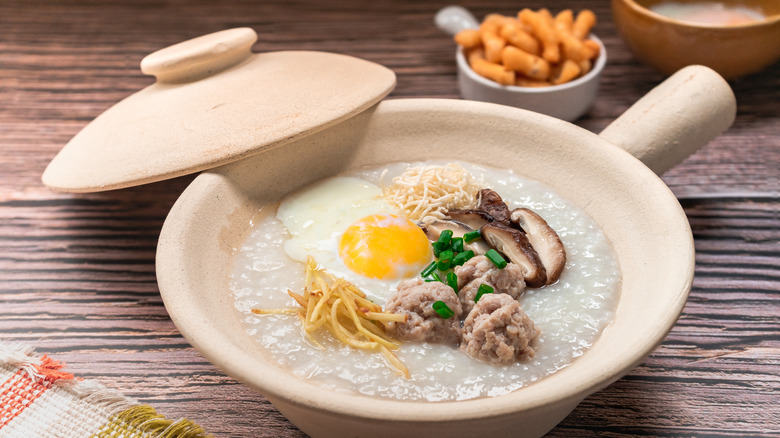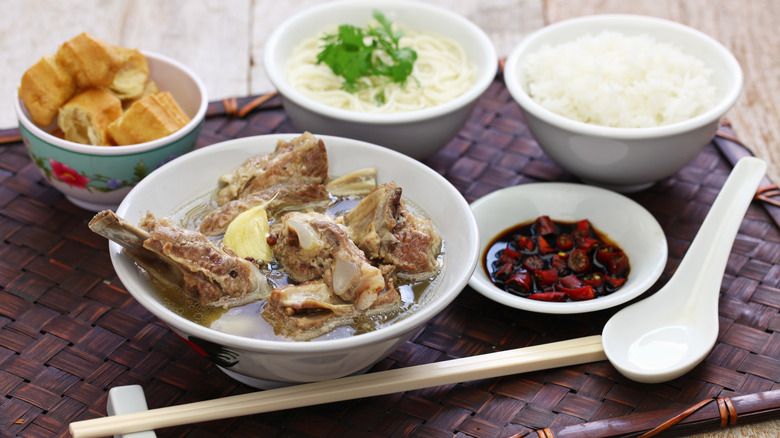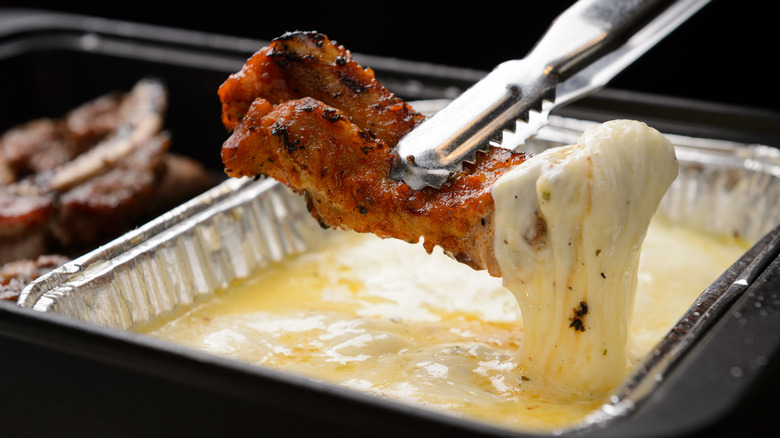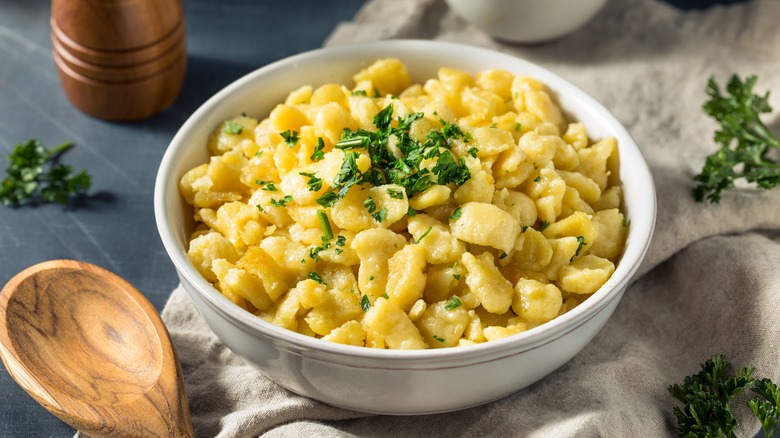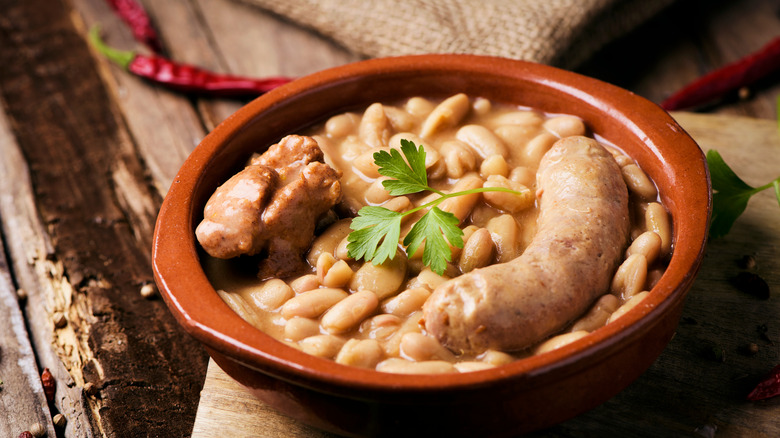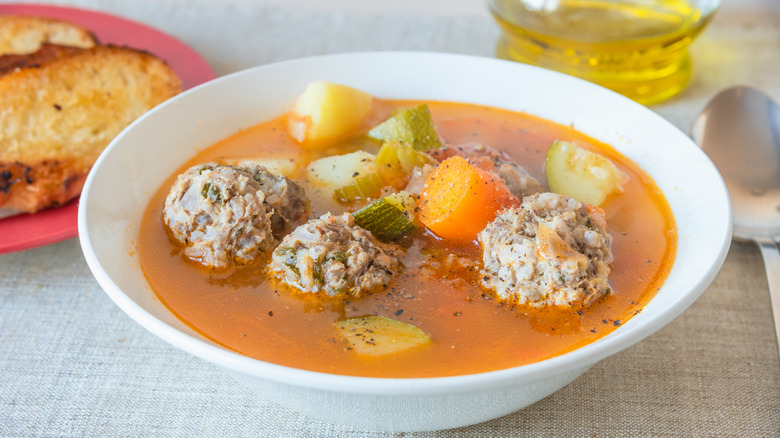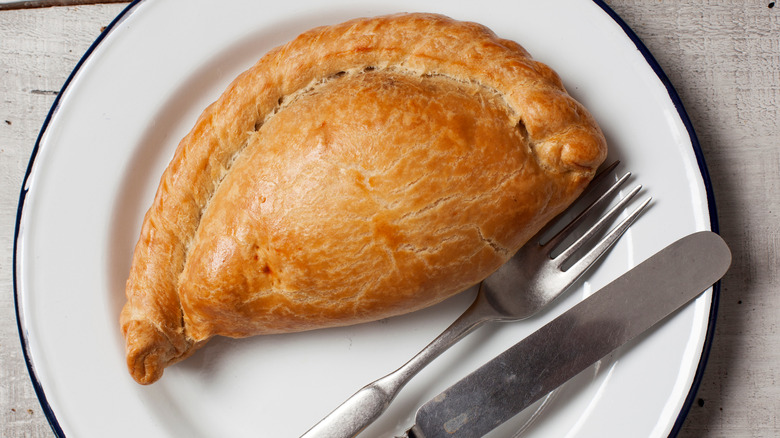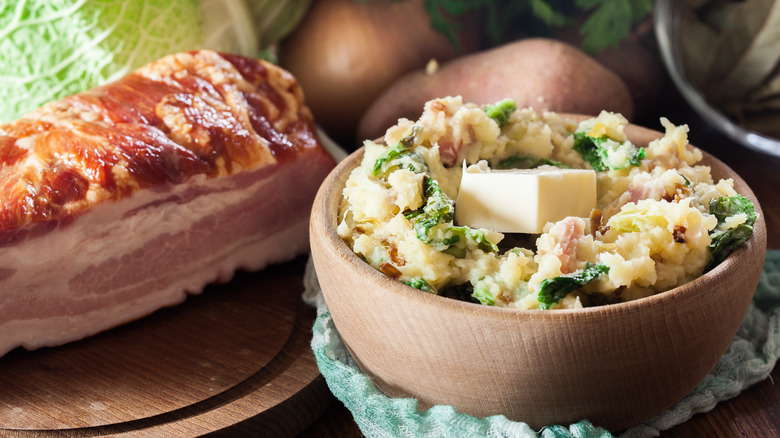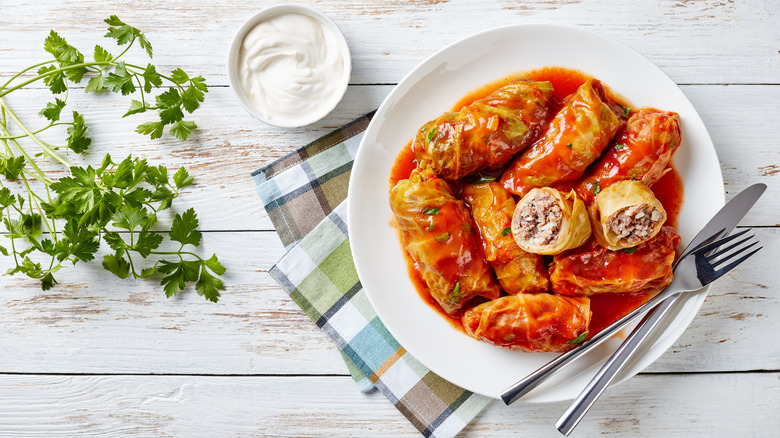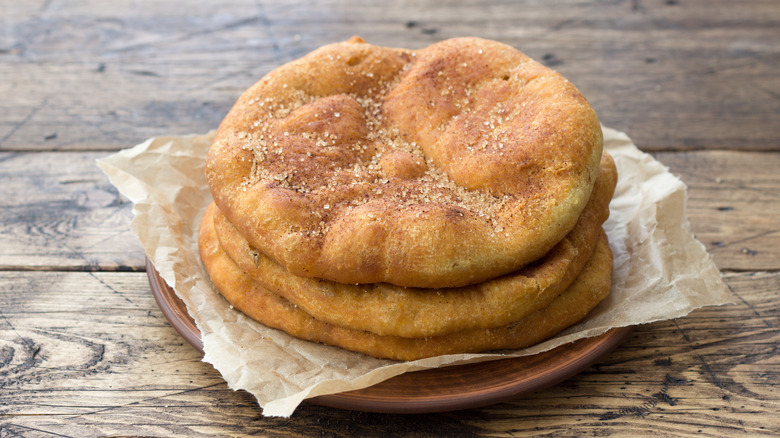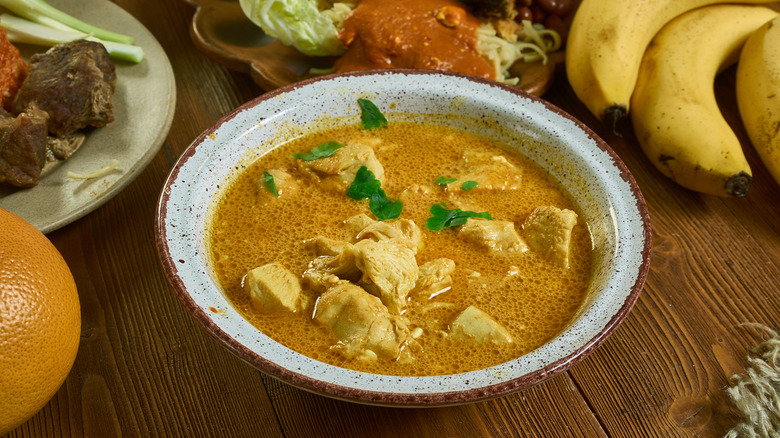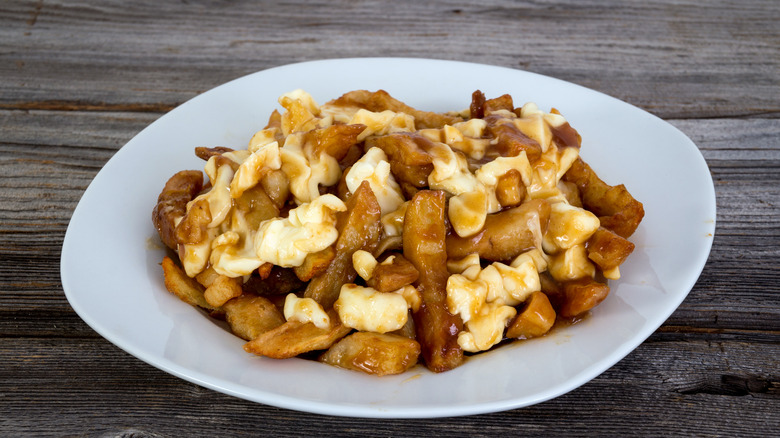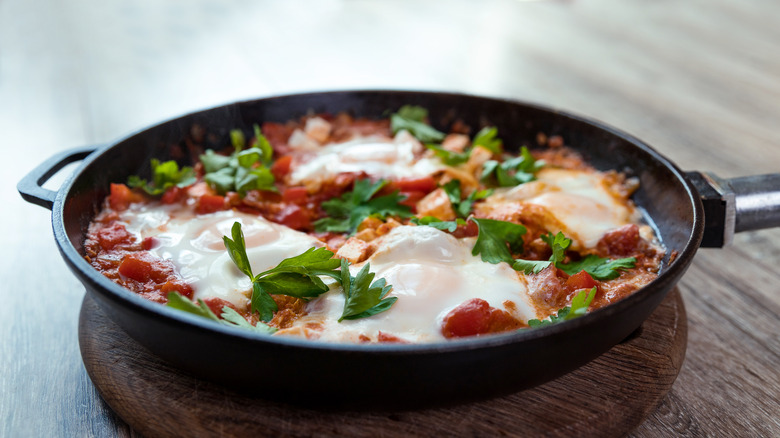Comfort Foods From Around The World
Comfort foods are foods people associate with a time in their lives when they felt comforted, like childhood, when one's parents and other caring adults did what they could to make you feel better. Comfort food may bring up feelings of home and security, soothing an anxious mind or depressed spirit. These foods may be unique to an individual or part of a shared culture. They may be high in calories or not, hot or cold, sweet or savory.
The Atlantic reported that sometimes food can be used as a way to feel like you belong. For instance, eating a dish that was popular back home can make you feel less alone when you have it far from that place. You might also be feeling down and looking for a quick pick-me-up, so you indulge to feel better (via Desert Hope Treatment Center).
Though cultures and societies differ greatly, one great equalizer is humanity's love for foods that give us a sense of well-being. Those foods share similarities and differences, just like the people who find comfort in eating them.
Congee
Congee, or rice porridge, likely first arose during the Zhou dynasty in China around 1000 B.C. (via Food52). The word now associated with the dish, congee, came from the Tamil language of South Asia. But there are many different words across several cultures that refer to the dish. For example, in Cantonese, it's jūk, and in Mandarin, it's zhōu, according to Post Magazine. Many people remember their moms making congee for them when they were ill, because it's easy to digest, but it is also traditionally served for breakfast in many places or as a light midday meal (via SBS).
When Linda Gao moved away from home for the first time, from Australia to the U.K., she was drawn to teaching herself to make congee just like her mother had made while she was growing up. In SBS, she described that still today, eating congee "feels like meeting an old friend." Gao likened the dish to reuniting with an old friend with whom it feels like no time has passed even though you haven't seen each other for a long time.
The basic recipe is rice boiled in water, but variations abound. The rice could be boiled in cow's milk or coconut milk. Or another grain or legume could be substituted for the rice or mixed in with it. It may be served plain with side dishes, such as eggs or pickled vegetables. Or things could be added to the broth, like bouillon, chicken, fish, vegetables, and herbs (via food 52).
Bak Kut Teh
Bak kut teh translates to "meat bone tea" from the Hokkien dialect of Southeast Asia (via South China Morning Post (SCMP). It is not actually made with tea but instead is made from pork ribs boiled for hours in a spiced, herbal broth. Common spices include, but are not limited to, star anise, cinnamon, cloves, angelica root, licorice root, fennel seeds, and garlic. This dish is popular in both Singapore and Malaysia, where, naturally, variations exist.
According to the SCMP, in many ways, bak kut teh resembles the Fujian province dish niu pai, which uses beef ribs rather than pork. Several of the same herbs and spices are also used, and the flavors are comparable and both dishes are comfort foods in the region, best "savored on a cold rainy day," per SCMP.
Malaysia's first bak kut teh restaurants opened in the mid-1940s (after the end of World War II) in the port city of Klang. It also emerged in Singapore around this time, but didn't become really popular until 20 years later when it became a favorite street food.
Omurice
Omurice (or omuraisu) is a shortening of the two words "omelet" and "rice." It's a traditional Western-inspired Japanese dish of fried rice wrapped in a thin, fluffy omelet and topped with ketchup "loved by kids and grownups alike" (via No Recipes). In Japan, chicken fried rice is most often used, but in Korea, where it is also commonly eaten, omurice is often made with pork (via Odyssa). The omelet wrap can be difficult to do. No Recipes says that many people today opt instead to top the rice with scrambled eggs. Some people enjoy decorating the top of the omurice, squeezing out fun shapes with the ketchup bottle.
It is generally accepted that omurice originated at a restaurant in Osaka called Hokkyokusei in the 1920s, though some claim it was actually invented at Rengatei in Tokyo. Wherever it came from, omurice has become a beloved dish across East Asia. A similar, also popular dish exists in southeast Asia called nasi goreng pattaya that likely originated in Malaysia, further evidence that rice and eggs were meant to go together.
Cheese Deung Galbi
Cheese deung galbi (literally "cheese back ribs") is not for everyone, but it might be comfort food at its most indulgent. A Korean dish, cheese deung galbi is, at its heart, tender baby back ribs braised with spicy gochujang sauce dipped in gooey, melted Mozzarella cheese. But, of course, variations exist.
First, the heat level of the ribs can be made to order. While gochujang (literally "chili paste") has a satisfying umami flavor, it can also be very spicy! (Think Sriracha and sambal oelek, but savory.) Second, sometimes rather than Mozzarella alone, people will add corn, along with other ingredients, turning it into the appropriately named corn cheese.
Cheese deung galbi is perfect for sharing with friends and family, enjoyed as an appetizer or a full meal served with rice, kimchi, or Korean egg rolls. Because it is so messy to eat, restaurants may offer you a plastic glove to use to keep your hands clean, according to blogger, Miss YYC.
Spätzle
A fluffy little dumpling, spätzle (also spelled spaetzle) was born in the Swabia region of southwest Germany, per Master Class. The base ingredients are flour, eggs, whole milk, and depending on the recipe, the option of yogurt or sour cream. Different spices, like chili powder, can be added for a more piquant flavor. Esther, from Spaetzle Recipes, says, "When I was growing up, [spätzle] was on the menu at least once a week."
Being a starchy food, spätzle can be treated much the same as pasta or rice. Serve it alongside roast beef or juicy bratwurst, or top it with a red sauce, meaty stew, or green pesto. Really, you are only limited by your imagination. One popular variety is käsespätzle (käse means "cheese" in German), which is very similar to homemade macaroni and cheese.
To ensure its authenticity, Schwäbische Spätzle (spätzle made in Swabia) bears seals of Protected Geographical Indication (PGI), as awarded by the European Union. This is similar to how only champagne from the Champagne region of France can be called champagne (at least within the E.U.).
Cassoulet
Cassoulet is a stew-like casserole (or casserole-like stew depending on how you look at it) that is a specialty of the southern French region of Languedoc. The name comes from the special ceramic dish that it is traditionally cooked in, the "cassoule." France Today says that when [chef Philippe Puel] always thinks of his grandmother when he makes the dish, saying, "For her, a cassoulet was a two-day affair," adding that when the stew was done, "it was extraordinary. We don't know how to make them like that anymore."
The traditional meats used are duck legs and pork sausage, though nowadays, several types of meat can be swapped in. Chicken for duck, for example, and turkey sausage rather than pork. It can even be made vegan. The other key ingredient is the white bean, which can be white kidney beans or Tarbais beans. Throw in some herbs and sometimes root vegetables, like carrots and leeks, celery, and tomatoes. Some recipes include adding a layer of bread crumbs over the top to make a kind of crust.
Cassoulet is cooked slowly over the course of a few hours. Pair it with a nice Cahors or Malbec wine, a green salad, and freshly baked French bread. Bon appétit!
Sopa de Albóndigas
Fry up some meatballs, then simmer them in a tomato-based soup, and you have Mexican sopa de albóndigas (literally "meatball soup"). Well, those are the basics anyway.
According to Delighted Cooking, this soup descended from the middle east when the dish arrived in Spain with the Muslims when they ruled part of Southern Spain from the sixth to 13th centuries. Spanish conquistadors then brought the recipe with them when they sailed to the Americas and colonized what is now Mexico, where, passed down through the generations, it evolved into the soup of today. Rosemary Bliss says on Flickr, "[My] mother learned to make this from my father's grandmother."
For the meatballs, either poultry or beef may be used (via Taste Atlas). They may be seasoned with smoked paprika, coriander, garlic, onions, and breadcrumbs. They are then simmered alongside vegetables, such as celery, carrots, and potatoes (via Ang Sarap), and topped with things like sliced avocado, salsa, grated cheese, or chopped green onion. And you can't forget the freshly made corn tortillas!
Pasties
The humble pasty (that's pronounced with an "a" sound as in apple) began life as far back as the 13th century as a food for the wealthy. But pasties are really known as food for miners — Cornish miners to be precise. Today, pasties are part of Cornish culture and tradition (via Owlcation) within the U.K. and beyond.
A traditional pasty is a half-circle-shaped pastry filled with beef, potatoes, onions, and rutabagas, though a variety of fillings can be used. The ingredients are cooked inside the pastry, which creates a satisfying gravy. The portability of the pasty is what makes it such a convenient meal.
When rich veins of ore were discovered in Michigan's Upper Peninsula (U.P.) in the early 1800s, skilled Cornish miners immigrated to the region and brought pasties with them. The other miners were so impressed by them that they, too, adopted the pasty for their lunches. Thus pasties have become beloved comfort food for Yoopers (residents of the U.P.) and Cornish alike.
Colcannon
By the 1700s, potatoes had migrated to Ireland and taken root not only in the ground, but in the cuisine. Nowadays, on bags of potatoes sold in shops, you might find a recipe for this beloved Irish dish, colcannon. Kelley Martin says in Healthy Diet Options, "Of all the dishes [my grandmother] used to make, Irish colcannon is by far my favorite."
Colcannon is a simple mash of boiled potatoes, kale or cabbage, and leeks. The name is either derived from the Gaelic "cal ceannann" (white-headed cabbage) or the Old Irish "cainnenin" (garlic, onion, or leek). It can be eaten as a mash or put into a baking dish and baked in the oven for about half an hour. Leftovers can be fried into potato pancakes.
While colcannon can be eaten at any time, it was once a tradition to eat it on Halloween. For centuries in Ireland, this night was called Colcannon Night. A variety of trinkets, such as a ring or coin, were hidden in the colcannon. Whatever trinket a person received determined their fortune for the year. For example, the ring meant marriage.
Cabbage Rolls
So many cultures love cabbage rolls that it was impossible to highlight just one (via La Jolla Light). You may know them as golabki (Polish), holubtsi (Ukrainian), sarmale (Romanian), mahshi kromb (Egyptian), or some other name, but they all have one thing in common: stuffed cabbage.
The Ukrainian holubtsi varies by region. Sometimes corn grits are used in the stuffing, other times buckwheat. Spiced ground meat and onion are also traditional. After being placed into a pot, broth is poured over the rolls, then they're topped with sour cream, and the dish is baked until the cabbage leaves are soft.
Polish golabki are very close to holubtsi, but may be topped with a specially blended tomato sauce. Gala Mukomolova, in the Crazy Wisdom Community Journal, associates golabki with her mother, who gave Mukomolova the pet name "Golubchik," or little golabki.
In Romania, where they are called sarmale, the cabbage leaves are stuffed with ground meat, rice, herbs, and spices. Rather than broth, these cabbage rolls are cooked in a special tomato juice. Egyptian mahshi kromb are made in a similar manner.
Frybread
Though controversial, frybread is beloved by many Native Americans across the U.S. When the Navajo were forced from their ancestral lands to settle in unfamiliar regions, their ability to hunt and raise their own food was crippled. The U.S. government sent them base provisions that included wheat flour, a staple to Europeans, but not to people of the Americas, where wheat is not a native crop. Frybread was born of these unfamiliar ingredients and a little ingenuity.
This simple dough is made from flour, salt, sugar, baking powder, and water (via Redheaded Blackbelt). It is then formed into balls, flattened, pierced a few times to make small holes, and deep fried. The result is a little like an elephant ear. They can be eaten plain, topped with Nutella or powdered sugar, or made into a taco.
Frybread competitions are a much-anticipated part of many powwows, and stands making it can be found at other gatherings as well. Kayla Maulson has fond memories of first trying her hand at making frybread when she was around 8 years old for her father (via Redheaded Blackbelt). She now owns and operates the popup food stand Frybread Love with her mother, sister, and cousin, sharing the love and tradition far and wide.
Groundnut Soup
Groundnut soup, or peanut butter soup as it is sometimes known, is an important part of West African cuisine (via African Food Network). A paste is made from the groundnuts which is then thinned with water or soup stock for flavoring. Peanut butter may also be used (via Feel Good Foodie). An array of cooked meats, vegetables, herbs, and spices are also added depending on the region and personal taste. Food blogger Lois, of Yummy Medley, says that groundnut soup "is a common staple in special events such as weddings and even funerals," events that tie a community together.
Bitter leaf, which is native to West Africa, is a common component of groundnut soup (via African Food Network). The bitterness of the leaves is what gives the plant its name, but all parts are used for medicinal purposes. It is traditionally used to treat malaria, which has shown some real merit. Groundnuts are also good for one's health, providing a good amount of protein, Omega-6, fiver, and more (via African Food Network). The soup is often served with rice, fufu (a mashed starchy food), fonio (an ancient grain), or other sides.
Poutine
Poutine is one of Canada's most celebrated foods. These French fries topped with cheese curds and gravy originated in Quebec in the 1950s. No one knows for sure, but it is thought that a customer requested that Fernand Lachance put cheese curds on French fries. The fries grew cold too quickly, so the gravy was added to keep the dish warm.
In the 1980s, poutine had grown beyond its provincial borders and became a popular street food in neighboring Ontario as well as at home. In the 1990s, poutine was added to the menus of fast-food restaurants like McDonald's. Tony Nassif says in Men's Journal, "It's a real comfort and a guilty pleasure for a lot of Québécois and for myself, a native Montrealer. It's one of those things that really hits home."
Nowadays, restaurants devoted entirely to poutine can be found, and almost anything can be put on fries. Even vegan poutine exists by substituting vegan cheese and gravy. Because the hot gravy melts the cheese, and the fries become soft after soaking up the gravy, poutine is generally eaten with a fork.
Shakshuka
An Arabic slang term for "mixture," shakshuka is another dish that crosses borders. Variations exist in countries all around the Mediterranean. Using a skillet, herbs, spices, and occasionally some greens or vegetables are cooked in a tomato sauce. When the sauce is ready, eggs are added (up to four seems to make the best fit) and poach in the mixture. Shakshuka is eaten at any time of day. The extra sauce can be sopped up with bread.
Shakshuka is particularly popular in Israel, brought to the country by immigrants from North Africa, where it may have originated. When made with spinach, mangold, and cream, it's called green shakshuka. Chef Tariq, who grew up in neighboring Jordan, has fond memories of his grandmother gathering fresh eggs from her chickens and using them to make shakshuka for breakfast.
In Italy, shakshuka is known as the somewhat dramatic uova all'inferno (eggs in hell) or uova in purgatorio (eggs in purgatory). The eggs represent human souls, and the surrounding bubbling red tomato sauce is either hell or purgatory (via Savoring Italy).

